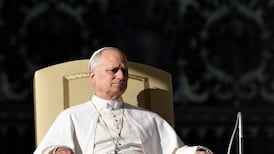Monday, Labour Day, is a public holiday to honour the American working class which is less influential than it used to be in the life of the country. This year US labour has cause for celebration: the victory of the Teamsters Union in the two-week strike against United Parcel Service (UPS), the first in more than 20 years.
Peter J. McGuire, founder of the Carpenters' Union in 1881 and co-founder with Samuel Gompers of the American Federation of Labour in 1886, campaigned for a Labour Day. He proposed to the Central Labour Union of New York in June 1882 "that the first Monday in September be celebrated as a Labour Day holiday".
L.A. O'Donnell, a labour historian, writes on the issue in the newly-published Irish Voice and Organized Labour in America (Greenwood Press, Westport, Connecticut, and London), an important work. McGuire's parents were famine refugees who arrived in New York in 1847 and settled in the teeming Lower East Side. Peter was born in July 1852. His father, a porter at Lord & Taylor's department store, taught Irish at the Cooper Institute. It's likely McGuire learned Irish from his father. He died in poverty, excluded from the AFL and the Carpenters' Union. "It is not extravagant to argue that the American Federation of Labour could not have succeeded without the building block of the carpenters' union, an organisation crafted almost single-handedly by P.J. McGuire," O'Donnell writes.
This study of 12 Irish-born and Irish-American trade union leaders, who established labour rights in the era of the "robber barons", is well researched and a pleasure to read. They include Terence Powderly, Master Workman of the Knights of Labour, an American Fenian; Frank Roney of Belfast and Patrick Joseph McDonnell of Dublin, and P.H. McCarthy from Limerick who became "lord of the building trades" in San Francisco.
McDonnell and Roney were IRB members. The former, of a prosperous family, was educated at Newman's University and expelled for being a revolutionary. He and Roney were imprisoned in Mountjoy without trial. On release, McDonnell emigrated to England, joined the International Workingmen's Association, was made Irish secretary by Marx, and when the IWA transferred to America, he went as secretary. Roney went to California and "dominated the labour movement in San Francisco during 1881-1886", a biographer wrote.
Samuel Gompers said McDonnell took "a leading part in the development of the American trade union movement", and suggested that he learned what he knew about labour from McDonnell and his friends. Two US Communist leaders and a labour icon are included: Elizabeth Gurley Flynn, William Z. Foster and Mary Harris, better known as Mother Jones, a powerhouse in coal mine strikes.
Gurley Flynn, the "rebel girl" of the Wobblies, lived next door to James Connolly in the Bronx. Foster's father, according to the son, was a Fenian "whose main interest was independence for Ireland [and] militant Irish nationalism".
As a syndicalist organiser, Foster led the great US steel strikes of 1919, which failed. John Fitzpatrick, born in Athlone in 1871, the son of a retired British army sergeant, emigrated as a boy to Chicago when his parents died. There he built the Federation of Labour. "He was not a socialist," O'Donnell writes. He backed women's suffrage and equal rights for blacks and continued to "organise the unorganised".
He supported de Valera during his US campaign for the Irish Republic in 1919-1920. Over the opposition of the hierarchy of the AFL, Fitzpatrick tried to create a US Farmer Labour Party in the 1920s. Three causes inspired his career, O'Donnell writes: labour, Irish independence and social justice. He died in 1946.
Finally, three chiefs of the CIO - the Congress of Industrial Organisations - during the great depression: Philip Murray, organiser of the Steelworkers Union for the CIO; John Brophy, righthand man of United Mine Workers leader John L. Lewis who made him director of the CIO; and Michael J. Quill, organiser of the Transport Workers' Union of America among Irish-born New York subway workers in the 1930s.
Murray's grandparents left Ulster for Lanarkshire, Scotland, probably in the 1840s. Brophy's parents emigrated to Lancashire during the famine. Both grew up in mining communities. In December 1890 the Brophys emigrated to the bituminous coal mines of central Pennsylvania. Thirteen years later the Murray family emigrated to Westmoreland County near Pittsburgh. Murray and Brophy followed their fathers into the mines and John L. Lewis recruited them to help him build the CIO.
Quill was born in Killgarvin, South Kerry, in September 1905. His politics reflected his background and in the Civil War he joined the IRA. At 20 he emigrated to America, was hired as a ticket agent by the Interboro Rapid Transit Co in New York, and found his mission in life - building a union. Jim Gralton of the Irish Workers' Club gave Quill a Connolly pamphlet, The Axe to the Root, on building a union. Gurley Flynn and Foster advised him. With a half dozen others he launched the Transport Workers Union in the New York subway system and took it into the CIO in 1937. It is still a force in New York City, but there are few Irish members now. He died in 1966 after winning a 12-day transport strike that brought New York City to a standstill.







